Beginning in about 1831 the first Catholic priests began visiting New Castle, Pennsylvania, and providing Sunday services to the local population. It was not until 1852 that a small Catholic mission, an extension of the S.S. Peter & Paul Catholic Church in Beaver, was opened in New Castle. The Reverend Peter McGarvey was appointed as the first resident pastor of this permanent mission. A church building was erected in 1853 on West Washington Street opposite where Greenwood Cemetery now sits. A small Catholic cemetery was also established at that time.
The small mission quickly grew and soon achieved independent parish/church status as the new St. Mary’s Catholic Church. From 1855 until 1871 the church was served by the Reverends Thomas O’Farrell, John Farren, Thomas Walsh, and James Canevin. The latter was the uncle of the distinguished Reverend J. Regis Canevin (1853-1927), who served as the Bishop of Pittsburgh from 1904-1920.
In 1863 the Reverend James Canevin purchased a property for $4,000 near the downtown area of New Castle and plans were formulated to erect a new building there. Construction of a new church soon commenced along Beaver Street (to the north of North Street) in 1866. The work progressed slowly and the first service was finally held in the partially completed building in 1869. The membership of the church was approaching 1,000 souls, mainly Irish workers but also a smaller group of German and other European immigrants.
In early 1871 the Reverend William F. Hayes arrived to take over as pastor and immediately embarked on an ambitious plan of expansion. The Reverend Hayes was also a trained physician and served on the local Board of Health. He greatly assisted the local community during a smallpox epidemic during the winter of 1873-74.
Hayes immediately stepped up efforts to complete the new church and it was dedicated during a ceremony held on Sunday, September 23, 1871. Hayes purchased a nearby home for use as a parsonage and founded the first-ever parochial school in New Castle. The school was initially maintained by the Sisters of the Humility of Mary of New Bedford, and then by the Sisters of St. Joseph of Baden beginning in 1875. The school initially held classes at several locations until a large school building was opened beside the church in 1876. The school was located at the corner of North Street and Shenango Street (now the Columbus Interbelt).
In May 1873 the Crawford Kiefer farm, totaling about sixty acres, was purchased for $6,000 in Union Township and a new church cemetery was laid out on about ten acres of the property. The remains in the old burial ground were soon reinterred in the new cemetery – located at the intersection of Harbor Road and English Avenue.
The financial-based Panic of 1873, which was the beginning of the “Long Depression” of 1873-1879, led to severe fiscal complications for the church. Many suddenly unemployed parishioners of the St. Mary’s packed up and left town in search of work. At least a portion of the Union Township cemetery property was sold off to prevent the church from going bankrupt. When Hayes departed for a new assignment in early 1879 the financial affairs of the parish were in bad shape.
The Reverend Joseph F. Gallagher (1844-1906), an accomplished musician, arrived in February 1879 and took over as pastor. Gallagher was born in Ireland, had come to the United States with his parents when he was about five years old, and settled in Philadelphia. He studied at various locations to become a priest, including at St. John’s University in Frederick, Maryland. Gallagher, much like his predecessor, took a great interest in the parochial school and worked to expand it. His efforts led the parish back to financial stability during the 1880s. “Father Joe” served the church for the next twenty-seven years and was highly revered by the local community.
In the late 1880s a group of German ethnic parishioners of St. Mary’s successfully petitioned the Diocese of Pittsburgh for their own church. As a result the new St. Joseph Catholic Church was established in New Castle in August 1888. It was after this time that St. Mary’s, losing several hundred parishioners, essentially became an Irish ethnic congregation. The church also established a small mission in Mahoningtown in 1900, which became the independent St. Margaret Catholic Church in 1904. St. Mary’s also played a part in the establishment of numerous other churches in the coming years to include St. Vitus (1900), Madonna of Czestochowa (1902), St. Lucy (1912), and S.S. Philip & James (1922). These new congregations were not official missions, but St. Mary’s is considered the mother of all Catholic Churches in New Castle.
Gallagher’s unexpected death on August 11, 1906, during a trip to his hometown of Philadelphia, was a huge blow to the city of New Castle. He was laid to rest in a prominent location in St. Mary’s Cemetery and the New Castle News of Wednesday, August 15, 1906, reported, “It was one of the largest funerals ever held in this city and the attendance showed the high respect in which the departed father was held, both by his brother priests and by the people of the community in which he had so long resided… The body lay in state at St. Mary’s church until 9:30. The remains were dressed in the full robes of the priestly office. Just before the Office of the Dead was chanted at 9:30 by the clergy, the children of the congregation passed about the bier and viewed the remains. Solemn Requiem High Mass was celebrated at 10:00… Rt. Rev. Mons. John Boyle of Johnstown, vicar general of the Altoona diocese, delivered the funeral sermon. This occupied fully half an hour and was a glowing tribute to the departed.”
The article when on to describe the procession to the cemetery with, “Following the sermon came the sad march to St. Mary’s Cemetery, where the remains of Father Gallagher were consigned to their last resting place. At the cemetery, the blessing of God was delivered by Rt. Rev. Father Boyle… During the solemn march to the cemetery, the clergymen went in carriages, but it was impossible to secure sufficient equippages to carry any but the priests, so the members of the congregation followed upon foot.”
The Reverend Florence F. O’Shea (1863-1948), coming from an assignment in Sewickley, Pennsylvania, was called upon to assume the role of pastor. O’Shea was born in Ireland, came to the United States at a young age, and was raised in western New York. He studied at St. Bonaventure University and was ordained in Buffalo in 1889. O’Shea arrived in New Castle in November 1906 and took over a blossoming congregation that was expanding at a steady pace. O’Shea immediately concentrated on expanding the parochial school, while also exploring ideas to fund and build a new church.
In early 1908 the parish purchased additional properties located adjacent to the church. The New Castle News of Monday, February 3, 1908, reported, “An important real estate deal has just been completed whereby the St. Mary’s congregation comes into possession of two properties on Diamond street, First ward, located in the rear of W. A. Mayne’s bottling works on Falls Street. It is known as the Keast property. St. Mary’s congregation now owns considerable valuable real estate in the First ward in the immediate vicinity of that which they have just purchased. They have the large tract on Beaver and North street where St. Mary’s school and church is now located and own 100 feet by 165 feet on the north-east corner of Beaver and North streets and now the property on Diamond street.”
The same article elaborates on the purchase with, “The congregation have had the matter of building a new church under advisement for a number of years, but it has never been decided upon how to arrange the buildings. It may be that the church will be located on the land at the northeast corner of Beaver and North streets, moving the parsonage, but of course nothing definite has been decided about this.”
Work on an impressive rectory, designed by local architect Harry M. Wirsing, was begun on Beaver Street in late 1908. It was erected in a way to easily incorporate a new church being built alongside it. The New Castle News of Tuesday, August 10, 1909, mentioned, “St. Mary’s new parish house in North Beaver street, which has been built for the priests of St. Mary’s church, is completed and they have been residing there since Sunday. The house is the largest and most up-to-date of any parsonage in the city and is located opposite St. Mary’s church.”
Meanwhile, the talk of building a new church continued while the congregation continued to thrive over the next decade. The monumental events of the Great War (World War I) intervened and shelved those plans for some time. The congregation numbered about 3,000 parishioners by the early 1920s and Reverend O’Shea and two assistant pastors were holding four separate services every Sunday. Finally, by late 1923, the parish readied itself to erect a new church.
The new building would be situated at the northeast corner of the intersection of Beaver and North Streets. Plans drawn up by Joseph P. Brenot (1865-1924), an experienced architect from Oil City, were soon approved and construction bids were accepted beginning in late April 1924. Brenot was well known for designing many schools and churches throughout northwestern Pennsylvania. For St. Mary’s he designed a neo-gothic structure with twin towers, which was lined with many large windows. The exterior was to be constructed mainly of Indiana sandstone. The main sanctuary was designed to hold 1,000 parishioners and a full basement would also house additional facilities.
A groundbreaking ceremony took place on the afternoon of Monday, September 15, 1924. The next day the New Castle News reported, “Taking a brand new pick, Rev. Fr. Martin J. Brennan, broke the ground. Rev. Fr. O’Shea then thrust the new shovel in his possession into the newly broken earth and filling the shovel, made the start of the immense excavation that will be required for the basement of the church, when he threw it to one side.” Brenot passed away rather unexpectedly six weeks later and architect Harry M. Wirsing was brought in to oversee the completion of the church. The cornerstone was laid on May 24, 1925.
The New Castle News of Tuesday, July 26, 1927, reported, “Magnificent new church of St. Mary’s parish at North and Beaver streets, massive in keeping with the Gothic type of architecture used, but bearing the refining and graceful lines of the modified influence of the French Gothic period churches such as Notre Dame and Rhiems, without the extravagant ornamentation that prevails in the latter type, is near completion… An outstanding example of the church architecture, it is one of the show places of the city and one of the finest church buildings in this section of the country. The church as it now stands practically completed is the last creation of the late J. P. Brenot of Oil City, an outstanding architect of churches in this country… The erection of this beautiful church was only possible through the efforts of Rev. Fr. F. F. O’Shea, the pastor, and the self-sacrifice and co-operation of the members of the parish. It is the result of years of untiring and unselfish efforts on their part as well as the assistant priests of the parish and many friends in this city.”
The massive structure took three years to complete and was dedicated on Labor Day, Monday, September 5, 1927. On that morning a throng of priests and other dignitaries gathered at the old church and then marched over to the new building. The New Castle News of the next day reported, “On the arrival of the procession at the front of the new church appropriate prayers were by the Rt. Rev. Hugh C. Boyle, bishop of Pittsburgh, the presiding dignitary of the service. He then proceeded, about the exterior of the church with his staff, blessing the “building” to its sacred usage and sprinkling its walls with holy water. Accompanying the bishop as his staff were the Rev. E. A. Heinrich, Rev. Kevin Guinagh, Rev. M. J. Brennan, Rev. F. S. Clifford, Rev. P. E. Maher, Rev. J. Dudley Nee, and other priests. When the entire building had been blessed and the bishop and his attending staff had returned to the front of the church, the church doors, were opened at the direction of Bishop Boyle.” The interior of the building was then blessed and the first mass was conducted in front of a packed house.
The Reverend O’Shea, after serving the congregation for almost twenty-three years, was given a new assignment in January 1929. He was tasked to take over as pastor of the prestigious St. Peter Catholic Church on the North Side of Pittsburgh. The Reverend Clifford served as the interim pastor for a few months until the Reverend Peter J. McKenna, in charge of St. Margaret Catholic Church in Mahoningtown since 1913, was assigned to become the next full-time pastor. McKenna served the church for a decade but died after a long illness in May 1939.
Two faithful assistant pastors, the Reverends William F. Galvin and Leo S. Watterson served the congregation for the next two and half years. Finally, in October 1941, the Reverend Francis M. McCarter (1894-1974) arrived from Bentleyville, Pennsylvania, to take over as pastor. McCarter, a native of Elizabeth, Pennsylvania, was a graduate of St. Vincent College and had been ordained in 1918. He was elevated to the status of monsignor in 1946 and became one of the county’s most respected priests.
During the 1950s the parish underwent a major rebuilding program. In the spring of 1950, the parish decided to build a modern parochial school and also a new convent for the school teachers (Sisters of St. Joseph). Work on the convent, which cost $100,000, began in the summer of 1951. It was dedicated on Sunday, January 5, 1952, and became home to fifteen nuns who taught at the school. The new facility, which cost $240,000 and housed grades 1-6, was built on the same site as the old school and was completed in early 1953. On Sunday, January 25, 1953, a dual ceremony was held dedicating the new school and celebrating the 100th anniversary of the congregation. The esteemed Reverend John F. Dearden, the Bishop of Pittsburgh from 1950-1958, was on hand to witnesses the joyous occasion.
In the summer of 1955, the parish spent $80,000 to make several improvements to the school and the rectory. A new four-room addition to the school, which cost $62,500 and added a junior high wing, was dedicated on Sunday, January 29, 1956. The revamped school building soon housed about 450 students in grades 1-9.
When the Reverend McCarter retired due to ill health in February 1969, after almost twenty-eight years of service, the congregation was in great shape. A new Parish Center (social hall), erected on the site of the old church building, was also opened in late 1969. McCarter was succeeded by the Reverend Raymond McColligan, who served as pastor until the summer of 1971. The Reverend Eugene J. Daugherty arrived from the Mt. Lebanon area and relieved McColligan in late July 1971.
In June 1972, after a sharp decline in attendance, the parochial school was ordered closed down by Diocese officials. The junior high classes had already been shuttered two years prior. The Sisters of St. Joseph vacated the convent after ninety-seven years of service at the school.
The New Castle News of Tuesday, June 23, 1972, reported, “The Rev. Eugene Daugherty, pastor of St. Mary Parish, said today the facilities would be released for an expanded program of special education in cooperation with the local school district. The planning is still in the discussion stage, he said. He said the 184 students at St. Mary easily could be absorbed into the St. Vitus and SS Philip and James Schools. St. Mary school was organized in one room in 1871 with the Sisters of St. Joseph taking over as educators in 1875 and the first building erected in 1876. It served not only as a school but as a social hall for the community. The present school building with 16 classrooms, cafeteria and other facilities was built in 1953. The third floor became a community meeting place until the addition of the Parish Center was made.”
The vacated school became home to the Little Bird Development Center, a special education pre-school program operated by the state, and the headquarters of the county’s “Head Start” child care program. In early 1974, after a boiler explosion at the New Bedford Elementary School, the facility also housed students from that school for a short time. In late 1978 the building was formally sold to the Human Services Center (HSC), a non-profit mental health organization established in 1963. The building was renovated and the HSC’s new Mental Health Center, which co-located and consolidated several offices, opened in the spring of 1980.
The former convent was subsequently used as a residence by the Sisters of St. Francis of the St. Francis Hospital, as a temporary home for the J. Bradley McGonigle Funeral Home, and as lodgings for a large family of Vietnamese refugees. In April 1977, after being renovated, it was rechristened as the new CCD Center for the church. Later the year, In October, the congregation celebrated its 125th anniversary.
In November 1989 the Most Reverend Donald W. Wuerl, the Bishop of Pittsburgh from 1988-2006, initiated the Parish Reorganization and Revitalization Plan. The goal of the project, deemed necessary by a growing loss of parishioners and a lack of priests, was to consolidate parishes and maximize the use of available resources. After preliminary studies, it was announced in June 1991 that 129 of the 332 parishes within the diocese were being examined for possible merger or suppression (closure). Seven churches/parishes in Lawrence County, but not St. Mary’s, were among the earliest slated for reorganization. Many of the affected congregations were dismayed by the news and aired their grievances.
Less than two years later, in March 1993, it was announced that St. Mary Parish would be suppressed and merged with the Madonna of Czestochowa Church to form the new Mary, Mother of Hope Parish. The two churches would remain open as “worship sites” for the time being. The Reverend Daugherty was also relieved from his duties as pastor and replaced with the ministry team of the Reverends Robert J. Cedolia and W. Peter Horton. The merger officially took place on May 29, 1993.
The reorganization plan, and the loss of the Reverend Daugherty, divided the congregation of St. Mary’s and emotions ran high. A small group of traditional-minded parishioners was extremely angered by the changes announced by the Diocese. They formed the “Congregation of St. Mary’s Church” and sued Bishop Wuerl in an attempt to halt the changes. The group believed Wuerl violated provisions of church and state law. They also believed the congregation should own the property, buildings, and money of the church, while the Bishop should serve solely as a “trustee” on their behalf.
The New Castle News of Friday, June 18, 1993, reported, “In May, Wuerl suppressed St. Mary’s parish and merged it with Madonna, rechristening it as Mary, Mother of Hope. Prepared to protect their church, St. Mary churchgoers, along with five other parishes in western Pennsylvania, have sued Wuerl in separate cases to block the closings and suppressions.”
When Wuerl visited New Castle in late August 1993 in was a prominent news story. The New Castle News of Saturday, August 14, 1993, announced, “Bishop Donald W. Wuerl of the Diocese of Pittsburgh will celebrate two masses Aug. 29 at the Mary, Mother of Hope Parish. The eucharistic liturgy will begin at 10 a.m. at the Madonna of Czestochowa worship site and noon at the St. Mary worship site.” About 150 parishioners protested outside St. Mary’s, while 800 others packed the inside and provided Wuerl with a warm welcome. During the visit, Wuerl also met with the leaders of the disgruntled parishioners and discussed their grievances.
The bitterness and pending legal action continued, but the case was essentially dismissed by a judge in January 1995. In time the protests died and the wounds of the congregation were healed. In the summer of 1996 the since-departed Reverend Robert J. Cedolia, reflecting on the events of August 29, 1993, told the New Castle News, “I think that the scene that day left an impression on the silent majority of the parish. When they saw the vocal minority, many asked, ‘Is this our parish? Is this what we want our parish to become?’ Many decided that it was not,” he said. “Afterward many people apologized to me, saying they didn’t support it and it was not what they wanted to see happening. The healing began.”
The Reverend Victor J. Molka Jr. arrived in June 1996 and served as pastor for the next sixteen years. He and an assistant pastor were kept busy tending to over 5,000 parishioners at two different sites. The congregation of St. Mary’s turned 150 years old in 2002, but it doesn’t appear any special celebrations honored the achievement.
In early September 2004, it was publicly announced that the Madonna Church would be closed by the end of the month. The last service, performed by the Reverend Molka, was held at Madonna Church on Sunday, September 26, 2004. Afterward, St. Mary’s, the lone remaining worship site, became known as the Mary Mother of Hope Catholic Church. Molka continued in charge of the combined congregation, and also became the administrator of St. Joseph the Worker Church in the summer of 2011. In July 2012 the Reverend Molka departed for a new assignment in Bethel Park.
That same month the Reverend Frank D. Almade, ordained in 1978, assumed the post of pastor of Mary, Mother of Hope Catholic Church. The Diocese of Pittsburgh, in a rather remarkable move, also installed him as pastor of all other remaining parishes in New Castle – St. Vitus, St. Vincent de Paul, and St. Joseph the Worker. Almade would be assisted by two parochial vicars or assistant pastors, and also by the Reverend Frank G. Erdeljac, a veteran of local service, who was living in retirement at his residence in West Pittsburg.
In July 2019, after a major reorganization featuring a “regrouping” of parishes within the Diocese of Pittsburgh, St. Mary’s became part of the new Holy Spirit Parish serving Lawrence County. She was merged with six other parishes to include St. Camillus, Christ the King, St. James the Apostle, St. Joseph the Worker, St. Vincent de Paul, and St. Vitus.
Mary, Mother of Hope is the oldest Catholic house of worship in New Castle and is still in active service today with over 2,000 members. In 2015 its website proclaimed its mission as, “We, the Parish family of Mary, Mother of Hope strive to continue the mission of Jesus Christ as faithful stewards of His church. Under Mary’s mantle, we proclaim and give witness to the Gospel values, cherish our history and traditions, and share our gifts. With the help of the Holy Spirit, we pledge to promote this in our parish community.”
 Construction of a larger church (shown above) on Beaver Street was started in early 1866, but not fully completed until the fall of 1871. (c1905) Full Size |
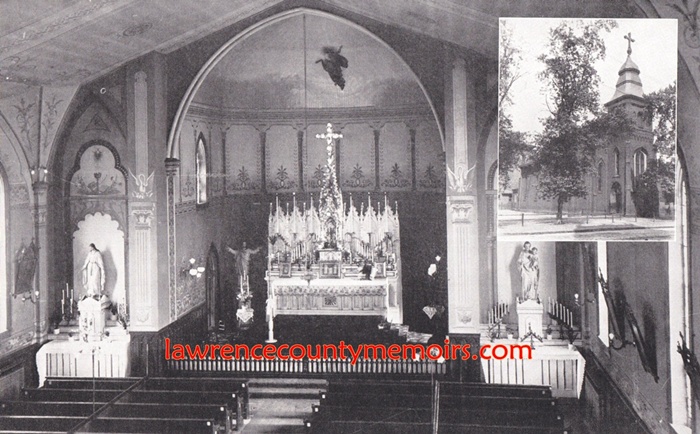 A view of the interior of the new church dedicated on September 23, 1871. The inset photo shows the exterior. (c1905) Full Size |
 |
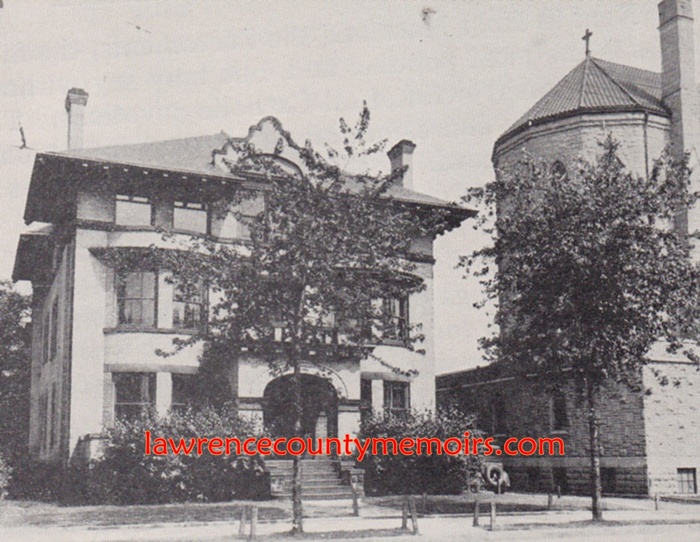 The new Rectory on Beaver Street was opened in 1909. Later, the new church (seen on right) was erected alongside it from 1924-27. (1927) Full Size |
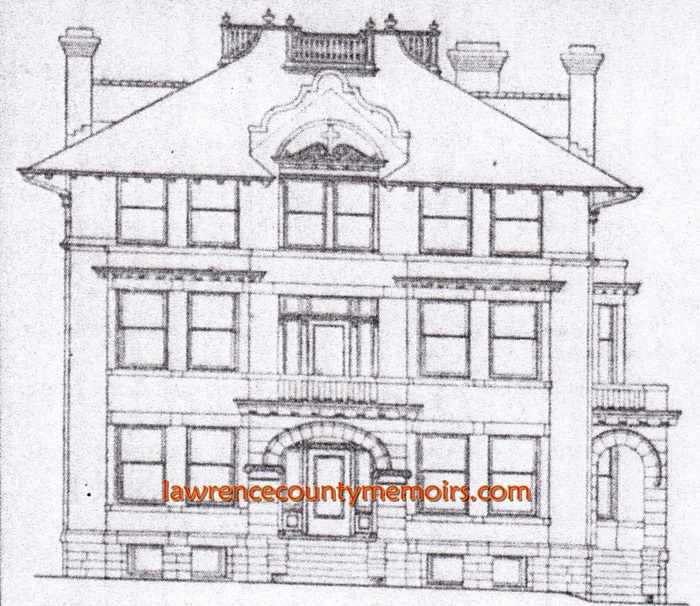 A proposed drawing of the large rectory, designed by architect Harry M. Wirsing and built during 1909. (1909) Full Size |
 The old convent on Beaver Street, which was replaced with a modern building in 1952. (1927) Full Size |
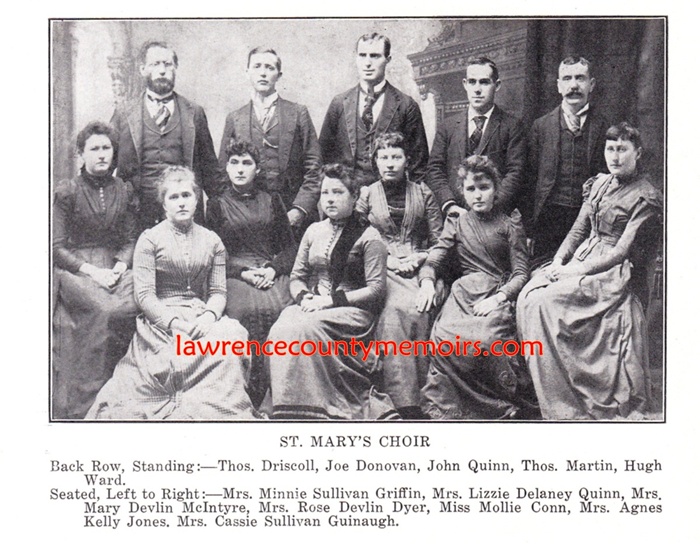 The choir of St. Mary’s Catholic Church. (c1900) Full Size |
 A group of altar boys from the church. (c1910) Full Size |
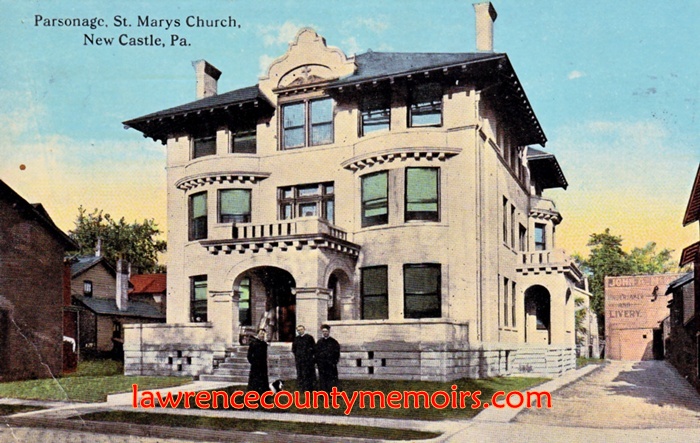 Another view of the parsonage. (c1915) Full Size |
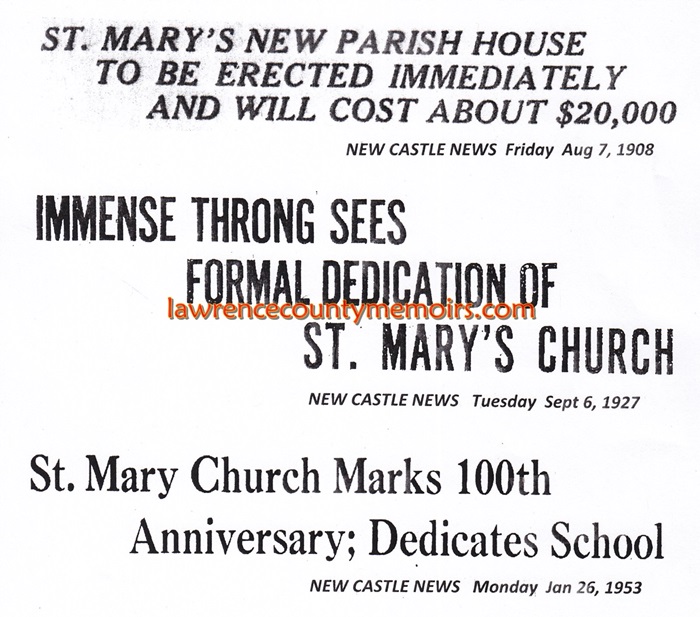 |
 During the early 1900’s the church grew under the pastorship of the Irish-born Reverend Florence F. O’Shea (1906-1929), and it was evident that a new church was needed. Ground was broken in September 1924 for this massive gothic-style edifice designed by architect Joseph P. Brenot. It was formally dedicated during a ceremony on September 5, 1927. Full Size |
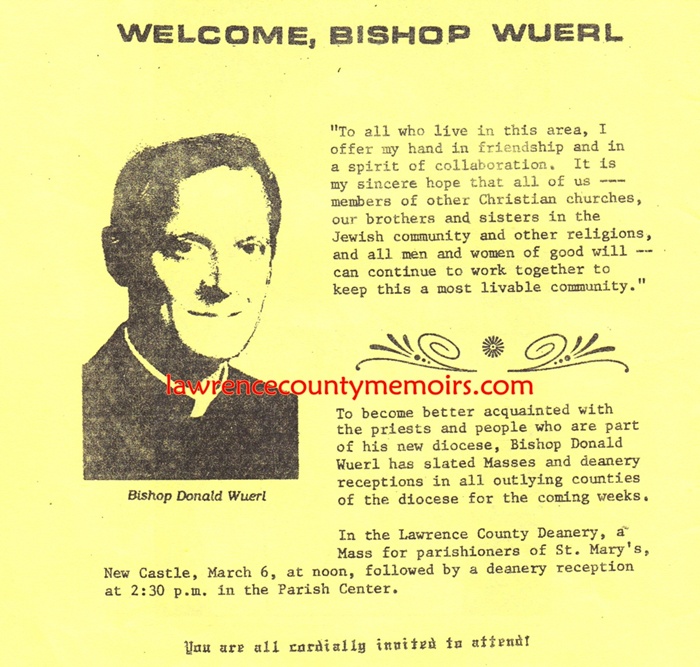 Part of a program announcing that St. Mary’s Church was hosting a visit by the Reverend Donald W. Wuerl on Sunday, March 8, 1988. Wuerl had been installed as the Bishop of Pittsburgh a month prior. He served as the Bishop until 2006, subsequently served as the Archbishop of Washington D.C., and was then elevated to the position of Cardinal in 2010. Wuerl, with a reputation for being tough on those clergy accused of sexual abuse offenses, became embroiled in a high-profile 2018 investigation concerning his mishandling of several such cases while he was the Bishop of Pittsburgh. He defended himself against public outcry but soon resigned as Archbishop in October 2018. (1988) Full Size |
 |  |
 In 1993 the church-parish was merged with that of Madonna of Czestochowa to form the new Mary, Mother of Hope Parish. Madonna Church was subsequently closed. (2012) |  |
 |
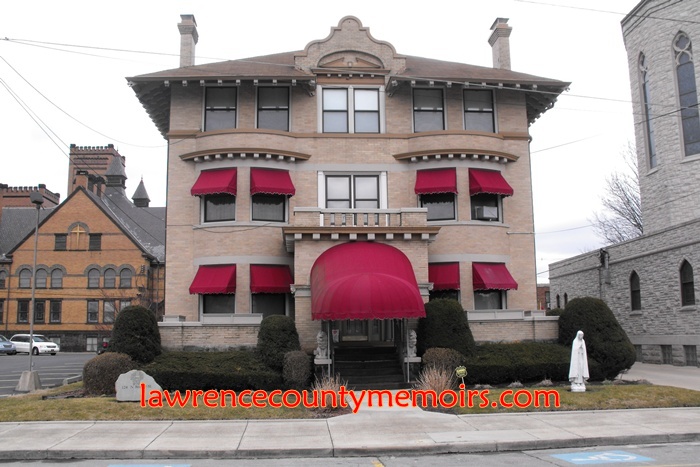 (Mar 2013) | 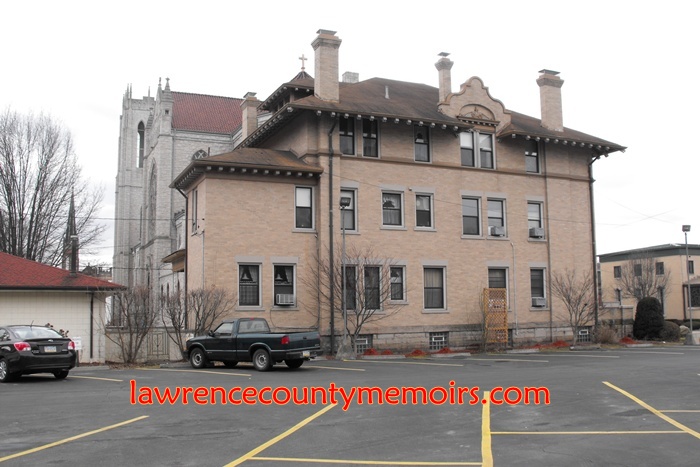 (Mar 2013) |
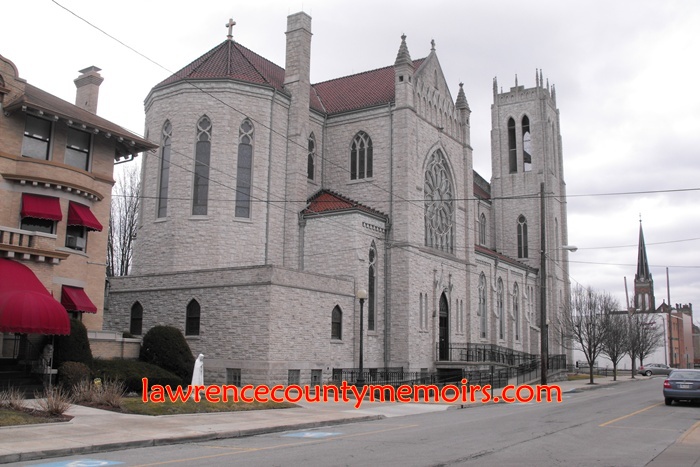 (Mar 2013) Full Size |
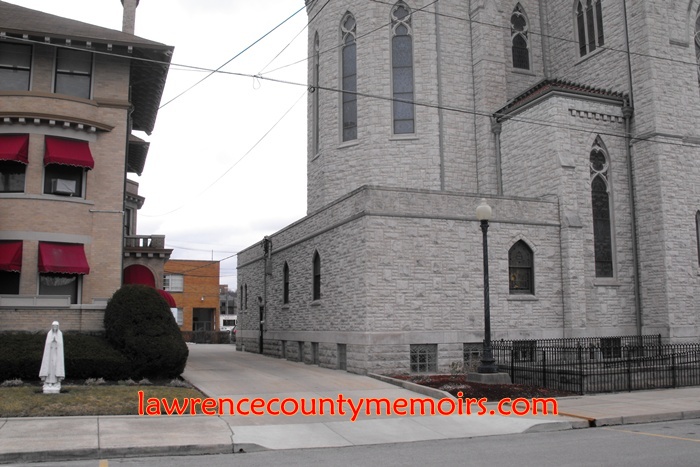 (Mar 2013) | 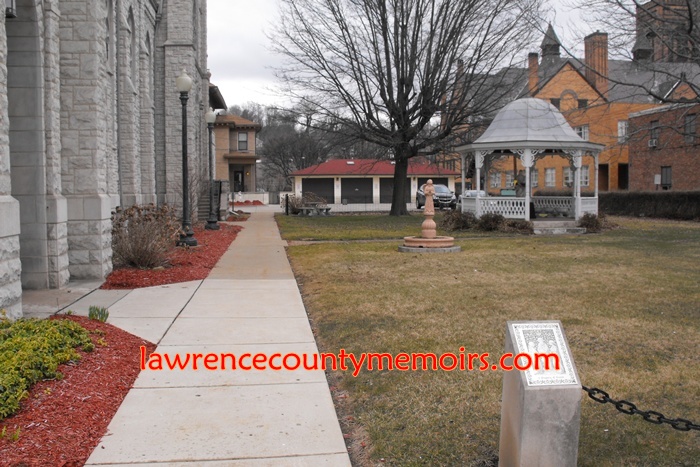 (Mar 2013) |
 (Mar 2013) | 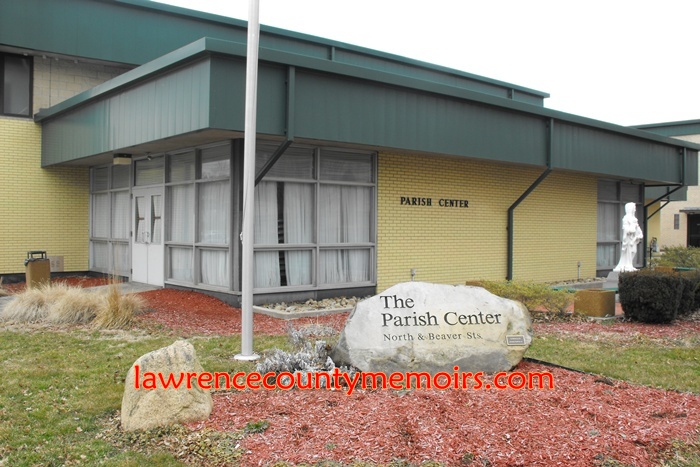 (Mar 2013) |
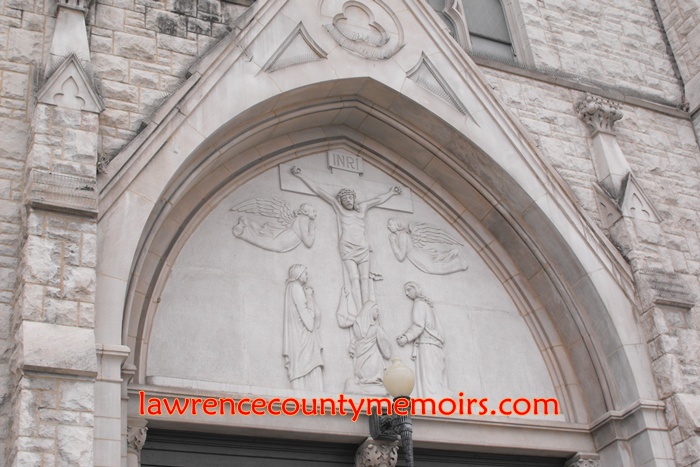 (Mar 2013) Full Size |
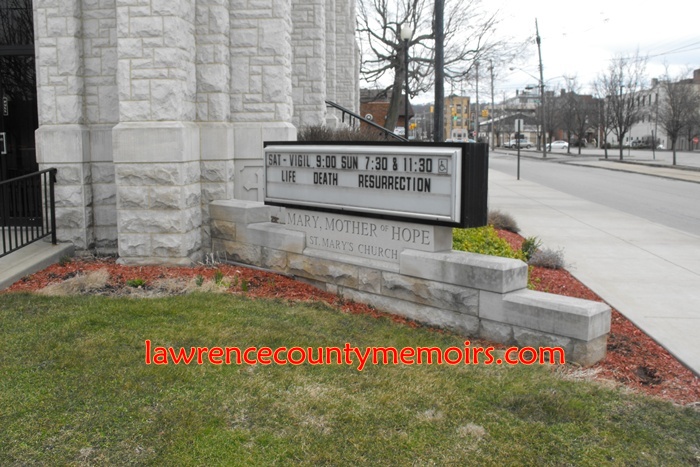 (Mar 2013) | 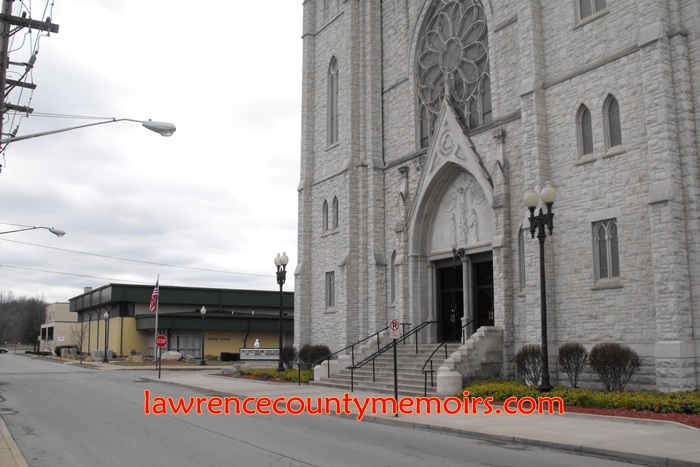 (Mar 2013) |
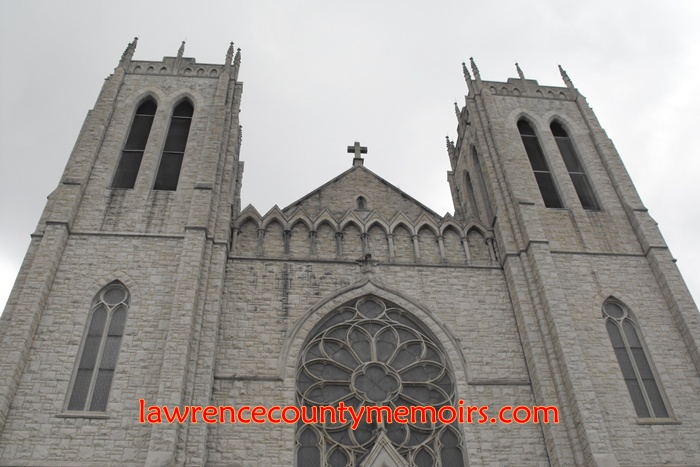 (Mar 2013) Full Size |
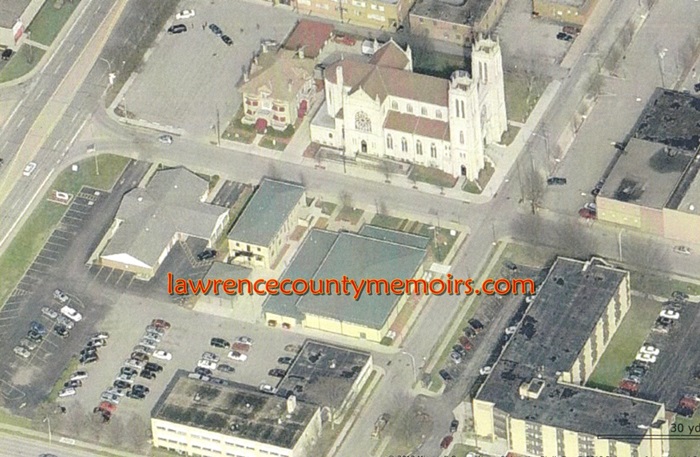 An aerial view of the St. Mary’s Catholic Church and related parish buildings. The church and rectory are pictured at top, the former parochial school in the center bottom, and the Parish Center and smaller convent building in center. (c2010) Full Size |




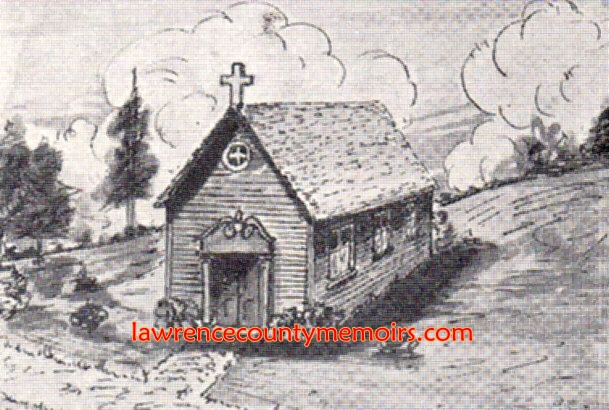
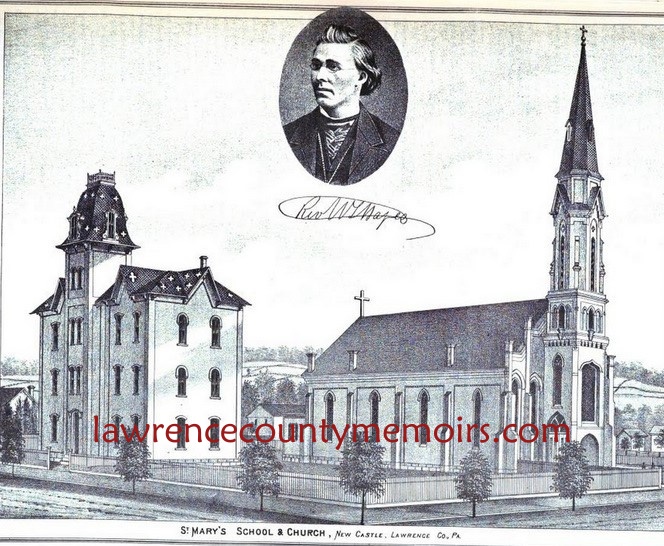
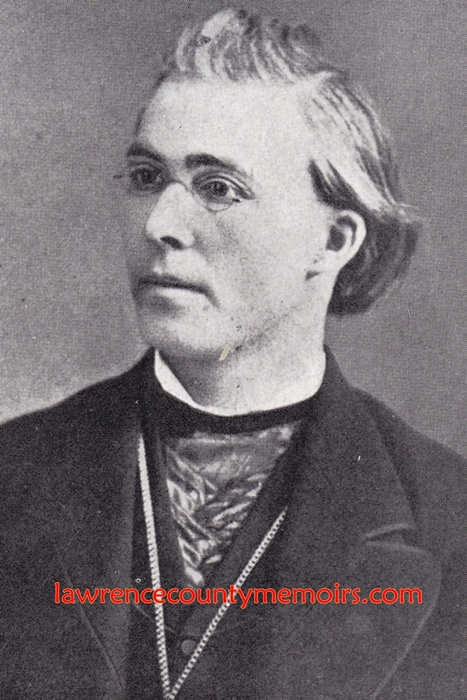
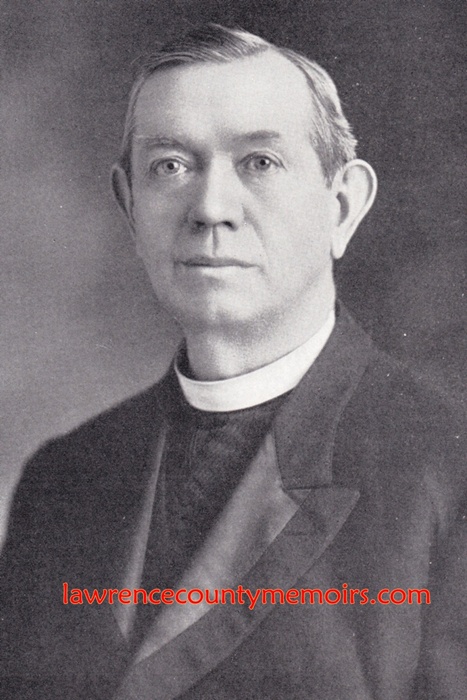
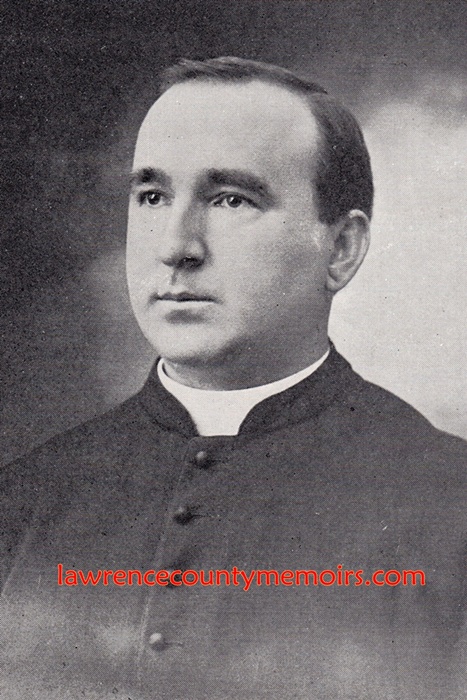
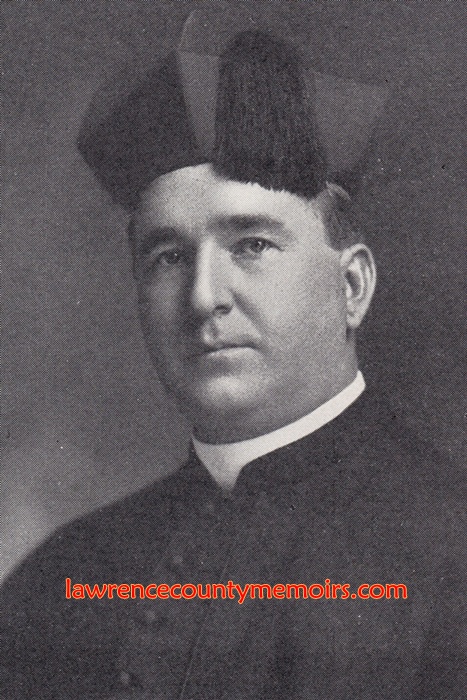


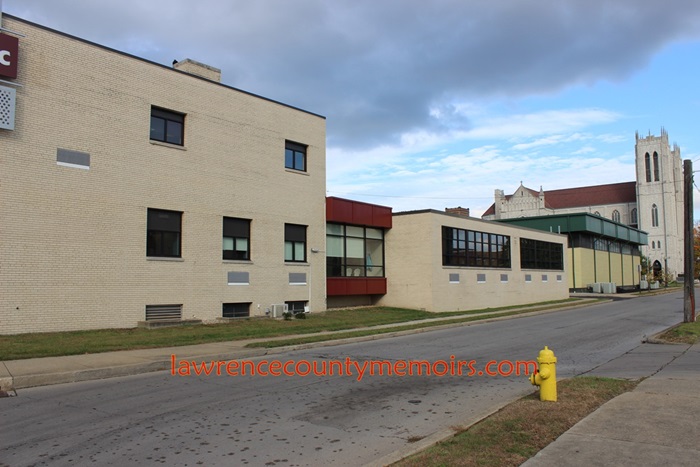

Comments
Ruth Webb #
Is there by some remote chance a list of the students who attended St Mary’s school in 1888-1890?
Jeff Bales Jr #
(EDITOR’S NOTE) Ruth, It’s possible. If I were you I would contact the Mary, Mother of Hope Parish office in New Castle and make an inquiry about their records. The number is 724-658-2564. Hope this helps. Jeff
Barbara A DeFIORE #
when did the 4:30 mass on sunday cease
Anne Heron #
Am trying to find out as much as possible about my uncle William Shovlin who died at New Castle Junction in 1949. He was from Ireland, I have a copy of his death certificate, he died in July 1949 aged 42 and was a Track Laborer, I assume he worked on the railway. He is buried at St Mary’s the death certificate says, assuming in the cemetery linked to the church. Just interested to know what life would have been like for him – an Irish immigrant, he is not listed as single. He left
Ireland when he was 20 years old.
Thank you.
Anne Heron
Jeff Bales (Editor) #
(EDITOR’S NOTE) Anne, I did a little research on this one. William Shovlin was born in Edergole in County Doneral, Ireland, in 1906. He was the son of Frances and Catherine Shovlin. He came to the United States in 1927 and settled in Youngstown, Ohio, with his uncle Patrick and aunt Louise Shovlin. Patrick was well established in Youngstown and had left Ireland back in 1904. He married Ohio native Louise in about 1912 and the 1930 Census lists Patrick and Louise has having five children (aged 2-17), including three sons and two daughters. William, who was single at the time, was also living there as well as another relative named Edward Shovlin, who was 15 years older than William. Patrick, Edward, and William all worked at a local steel mill. I can’t find much of a mention of him during the 1930’s. Sometime in the early 1940’s he relocated to New Castle, Pennsylvania, and took a job at a large railyard known as New Castle Junction. The New Castle News of Thursday, July 21, 1949, reported in part, “William Shovlin, aged 42 years, of the P. and L. E. Railroad Camp, at New Castle Junction, died Wednesday afternoon at 5 o’clock of a cerebral hemorrhage. He has been employed as a track worker by the P. and L. E. Railroad company for the past five years. Mr. Shovlin is survived by an uncle, Patrick J. Shovlin, of Youngstown, his mother, Mrs. Catherine Shovlin, of County Donegal, Ireland, and other relatives in Ireland.” I found no mention of him being married and it appears his nephews from Youngstown served as his pallbearers. He was interred at St. Mary’s Catholic Cemetery just outside New Castle.
So just what he did in the 1930’s and early 1940’s remains a mystery. I did find two possible mentions but they are not all that flattering. The 1940 Census lists a good match for him (William Shovlin, age 33, born in Ireland in 1907, marital status as single) as an inmate at the Allegheny County Jail in Pittsburgh, Pennsylvania. It lists his occupation as a crane operator at a steel mill. No offense or reason for his incarceration is given. There is another account of a William Shovlin being arrested in New Castle in February 1945 for public intoxication. The second arrest seems more like a solid match. A photo of that arrest/mugshot can be found at: https://webcache.googleusercontent.com/search?q=cache:PayMnafQR3cJ:https://smalltownnoir.com/2010/08/27/william-shovlin-drunk-10-feb-1945/+&cd=1&hl=en&ct=clnk&gl=us
I hope some of this is useful to you. I would caution that the arrest info would require further investigation to positively confirm it’s the same man as your relative.
Jeff
Jay Laisne #
Hello,
I was going through some old family belongings and I found the blue prints for the 1950 St Mary’s convent construction. My Grandfather William Manning was an Architect in Pittsburgh and worked on the drawings. I don’t know if you wold be interested in copy’s of them or photos or what but if this is something you might be interested in let me know.
Thanks.
Robert Gabriel #
gotta wonder why Father Daugherty is not mentioned. you saw fit to keep a reference to the now discredited Wuerl who oversaw the downfall of Saint Mary’s parrish.
Jeff Bales (EDITOR) #
(EDITOR’S NOTE) Robert, If you are referring to the Reverend Eugene Daugherty he is certainly not overlooked and is mentioned several times. Perhaps take another look. Also, Wuerl is mentioned because he played a part in the history of the church and his August 1993 visit, whether we like it or not, was quite a big deal. I don’t just concentrate on the “rosy” parts of history – I do my best to attempt to tell the whole story. Good and bad. The text above and all captions were written prior to Wuerl’s resignation in Oct 2018, but I will update it promptly to reflect Wuerl’s resignation. I will also update the text to include the official formation of the Holy Spirit Parish in July 2019. Thanks. Jeff
Sharon Ricklic #
Hello from New Philadelphia, Ohio!
My husband’s great great uncle was a Patrick H Brennan, a Jesuit Priest (b.1843 – d.1929). Family history tells of Fr. Brennan attending St. Mary’s church as a young boy. Fr. Brennan was pastor at Trinity Church at Georgetown University, among other Catholic Churches throughout Maryland, Rhode Island,and Massachusetts. I came across an article on the dedication of your church in 1927. The last paragraph states, “A wealth of ceremonial, conducted by Bishop Boyle, marked the dedicatory exercises. Rt. Rev. John Mark Gannon, bishop of Erie, delivered the dedicatory sermon. The first mass in the church was celebrated by Rev. Patrick H. Brennan, S.J. of Washington D.C. assisted by Rev. E.A. Heinrich and Rev. Kevin Guinagh, all natives of the parish.” This article was published in the Pittsburgh Press on September 11, 1927.
I was pleased to find this article to prove the family story of Fr. Brennan’s attendance and his family at your church.
We hope to visit your area when the weather breaks.
Thank you for your time,
Sharon
Barbara Ann Audia #
Hello,
I am wondering if there are yearbooks for the school that can be accessed online. Specially the years 1917-1925.
Thank you
Richard L Jenkins #
Could you direct me to where I can obtain a list of students from the 1963-1964 first grade?
Thanks in advance for your assistance
Comment